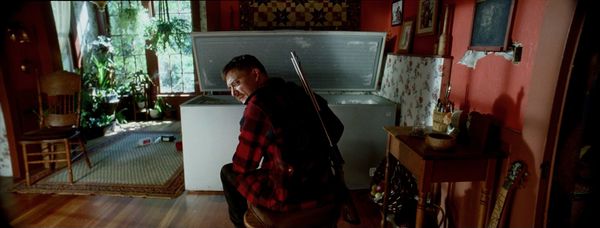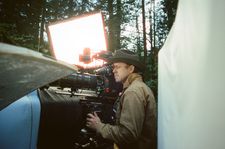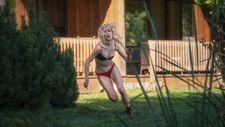 |
| Kyle Gallner in Strange Darling |
Already riding high at the US box office, and just screened at Frightfest, JT Mollner’s Strange Darling is a lively thriller which oozes style. Following two characters played by Willa Fitzgerald and Kyle Gallner, it plays with audience sympathies as they interact across six chapters presented in non-linear order. It’s gorgeously shot, on celluloid, by Giovanni Ribisi, and when I got the chance to speak with him (and JT), I asked about his interesting use of colour, as well as the way that the visual choices and sound design work together.
“JT can speak to the sound design,” says Giovanni, “but for the image, you know, the overall tone of the movie and the world that we wanted to create was really based on the idea of these two characters existing in a fairy tale, so there was that sort of subjective innuendo. A catchphrase for us was ‘blood on the flowerbed’, and that flowerbed is really the stepping stone or point of entry for this movie, I think.”
 |
| Behind the scenes on Strange Darling |
“I couldn't have said it better,” says JT. “We wanted to use colour as a weapon, you know? We looked at a lot of films to figure out composition. They were inspiring lensing and stuff like that. We watched The Servant and Mademoiselle and all these films. But then there were other films where the colour was really what was being used as a weapon, in a sense. Cries And Whispers...”
“...Mario Bava,” adds Giovanni.
JT nods enthusiastically. “Yeah – so we wanted to go in that direction. And then the sound design, you know, it's weird. I'm glad you asked about that because that's Andy Hay and John Warrin's company, Echo Sound. They just did the sound for Anora, which won the Palme d’Or.
“You like to find people that you're going to work with for life if they're available, and although I've worked with a lot of good people, that part of the team has never really been there as a fixture, for whatever reason. And so I called Sean Baker. I knew if he recommended somebody, they were going to be great. And he recommended these guys. And went into the mix with them and sound became such an important part of this movie. The music and the score – the soundtrack and Craig DeLeon's score. As a cocktail, all of this needed to be an assault on the senses. That means picture, sound, music, and just the feeling it invokes. We wanted it to have a very strong point of view.”
“I also remember you talking about the loud, quiet, loud idea from the Pixies and their whole impetus for writing music,” Giovanni tells him. “That was also really important, you know? So while there's an assault on the senses, there's still this fairy tale quality. That was really balanced with JT and the script and Chris Bell, the editor.”
I ask about the cast and, specifically, the chemistry between the leads, which is really essential to making the film what it is.
 |
| Willa Fitzgerald in Strange Darling |
“Even those performances were very much loud, quiet, loud,” observes JT. “There was one interview where somebody said ‘What was your biggest inspiration?’ I was like, ‘Well, the Pixies, this band...’” They both laugh. “I remember being a kid and listening to the Pixies,” he continues. “I loved really melodic and beautiful romantic music, and I also liked harder, punk rock type music, but there was only so much of one or the other I could listen to. And the reason I loved the Pixies so much, when my older brother introduced me to them, is because they had these beautiful moments and these very intimate moments in their music, and then they got really loud and got really quiet.
“I think in this movie, especially the performances, there's moments where they're very subdued, very natural, and then there's moments where they're incredibly explosive. They're all meant to be where they are. And usually in those subdued moments, it's just a moment of gear shifting before we're ramping it up to the next higher gear. We needed the actors to have that sort of chemistry, and we needed them to be able to rise to the occasion in those moments, and very few actors could have accomplished it. So I feel incredibly lucky to have Willa Fitzgerald and Kyle Gallner playing those roles.”
At this point we have to drop the conversation because there are a lot more people wanting to speak, but Paul Risker picks it up again later, saying that he’s surprised by JT’s reference to Cries And Whispers.
“Obviously, from a genre standpoint, it's very different to Cries And Whispers, which is a great film,” says JT. “We took visual cues from all the different genres because the obvious thematic equivalence would be other movies.
 |
| Kyle Gallner in Strange Darling |
“Cries And Whispers wasn't Bergman's first colour movie - I think it was his third or fourth. It was the first movie that I noticed he was using colour as a weapon. Colour is a very distinct choice in Cries And Whispers, and he uses it to sometimes inflict pleasantries and other times horror, but he uses it to his advantage throughout that whole movie. So, that was definitely one of the films, and Dead Ringers was another that used colour in that way - they're two very different movies.
The Red Shoes was another and also Blue Velvet. I looked at these as candy-coated movies that somehow utilise colour in a very specific way. It was something Vanni and I were both fascinated by, so, that was one aspect of the approach to Strange Darling.”
Giovanni agrees. “Even as a creative technique, we were talking about how Chekov said that the writer has one concept, and the actor or director have the exact opposite idea, and together they make theatre. I think that was an MO for us and when somebody goes to see a genre movie, a horror-thriller, they have certain expectations. So, there are specific landmarks you want to check off and expectations you want to fulfil to a certain degree. But you also want to defy expectations, or at least, I feel that was something we were very conscious of, whether it was right or wrong, whether we succeeded or not. It was like, 'Can you imagine, for instance, The Red Shoes as a horror film?' That was the idea and for some reason Cries And Whispers was in the conversation.”
“Cinema is still in its infancy, and we're exploring what the form is and can be. Regardless of right or wrong and whether a film is successful, we need to take chances and experiment to answer these important and necessary questions,” says Paul.
“We're in such an ultra-conservative phase of filmmaking,” Giovanni responds. “Part of that has a lot to do with society homogenising itself through all these aspirational tools: cellphones, Instagram and social networking. Suddenly everyone's famous and it's easy to do that.
 |
| Willa Fitzgerald in Strange Darling |
“The economics of filmmaking, even for a younger generation that would experiment or does want to hold up their middle fingers to the status quo, there is no entry point. It's like the LA real estate market - it's so expensive and there's so much red tape and so many regulations.”
“What you're saying is true and, like Vanni said, we're living in a very conservative era as far as filmmaking goes,” says JT.
“I knew I was influenced particularly by the films of the Sixties and the Seventies, but because I was a teenager in the Nineties, it didn't occur to me how much I was also influenced by this decade, when there were the last outlaw filmmakers. They still exist and there are still experimental, great and interesting movies - lots of them and I could go down the list. But it seemed more people were doing that and so that's what we wanted to do.
“Every bit of Strange Darling, even though it's within a genre, is meant to obviously appeal to people and to also be a ride - every scene is another act of defiance. Characters are doing things we don't often see them do on screen, and we didn't want to ever have any constraints on us, like, 'Maybe we shouldn't have a character do this.' We just let these characters be and if they wanted to chain-smoke, they were going to chain-smoke. If they said things that were offensive, that's what they were going to do. We just wanted to make sure we leaned into all the danger within the story and the characters, and just let them be free.”
“The film doesn't try to be too mysterious,” Paul observes. “Instead it relies on the characters to surprise the audience. Strange Darling is one of those films that will be interesting to rewatch because it's a study of human nature.”
 |
| Willa Fitzgerald in Strange Darling |
“There is a version [of this movie] to deconstruct and make a comment that it is math because of its non-linear sequence,” says Giovanni. “But every story has sequence and form. Joseph Campbell has sequence and that is an intrinsic part of Strange Darling. And it's true, we don't get caught up in, 'Oh, he was doing this,' or 'That was happening,' because the form and structure is driven by these characters and their juggernaut performances, that I believe are so powerful, and JT shepherding that.”
“I agree,” says JT, “and the actors are always focused on playing the truth of those characters instead of giving performance red herrings to be part of a twist or something. That was really important to us too, and when you watch the movie a second time, hopefully you'll watch those scenes, and you'll see all kinds of clues to different things, and you'll think, 'How did I not see that the first time?' We were never trying to cheat in our manipulation - the sequence was meant to do that work on its own.”





















